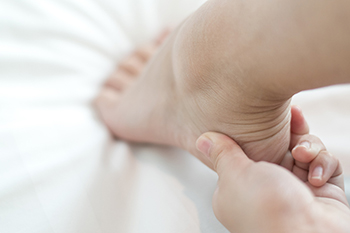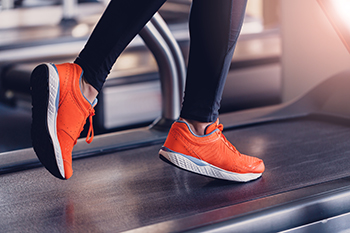Connect With Us
Blog

Sever's disease, also known as calcaneal apophysitis, is a common heel condition primarily affecting active children during periods of rapid growth. It occurs when the growth plate at the back of the heel becomes inflamed due to repetitive stress and tension from activities like running and jumping. This inflammation leads to heel pain, particularly during physical activity or pressure on the heel. To manage Sever's disease, it is essential to rest the affected foot and perform stretching exercises to alleviate tightness in the calf and Achilles tendon. Wearing supportive footwear with cushioning insoles can also help relieve pressure on the heel. If your child has heel pain that persists or worsens, it is suggested that you consult a chiropodist who can provide personalized care, including proper diagnosis, tailored treatment plans, and guidance on activity modification to promote healing and prevent recurrence of symptoms.
Sever’s disease typically affects young children and teenagers. If your child complains of foot pain, please consult with Paul A. Scotti, D.Ch from West Toronto Foot & Ankle Clinic Inc. . Our chiropodist will assess your condition and provide you with quality foot and ankle treatment.
What Is Sever’s Disease?
Sever’s disease, also known as calcaneal apophysitis, is an inflammation of the growth plate in the heel bone. It is typically caused by overuse due to repetitive activities such as running, jumping, and playing certain sports. This condition most frequently affects children between the ages of 8 and 14.
Symptoms
Symptoms of Sever’s disease include:
Pain in the back or bottom of the heel
Pain when the sides of the heel are squeezed
Limping or walking on tiptoes to avoid putting pressure on the heel
Difficulty running, jumping, or participating in usual activities
Fatigue
Diagnosis
Sever’s disease is diagnosed by taking a thorough medical history and performing a physical examination. Imaging studies, such as an X-ray, can help rule out other injuries like a fracture.
Treatment
Sever’s disease typically heals without any long-term complications. Treatment involves resting the affected foot by reducing typical activities, wearing orthotics to support the foot, immobilizing the affected foot, taking medications to reduce pain and inflammation, and stretching the foot.
If you have any questions, please feel free to contact our office located in . We offer the newest diagnostic and treatment technologies for all your foot care needs.

In the quest for preventing falls, caring for your feet is often overlooked, yet it plays a vital role in maintaining balance and stability. Your feet are the foundation of your body, and neglecting them can increase the risk of accidents and injuries. Proper foot care starts with wearing well-fitting shoes that provide support and traction, reducing the chances of slipping or tripping. Regularly inspecting your feet for any abnormalities such as ingrown toenails, corns, or calluses is essential, as these can affect your gait and balance. Maintaining good foot hygiene by washing and drying your feet daily helps prevent infections and skin problems that could impair your mobility. Additionally, keeping your toenails trimmed straight across can prevent ingrown toenails, reducing discomfort and potential complications. By prioritizing foot care as part of your overall health regimen, you can significantly decrease the risk of falling. If you have endured a foot or ankle injury from falling, it is suggested that you visit a chiropodist who can provide proper relief and treatment strategies.
Falls are a common but preventable problem for older adults. If you would like to learn more about preventing falls, please consult with Paul A. Scotti, D.Ch from West Toronto Foot & Ankle Clinic Inc. . Our chiropodist can help you maintain the health of your lower limbs and your mobility.
Did you know that most falls occur in the home? Fortunately, there are many simple changes that you can make to the living environment to reduce the risk of falling.
In the Bathroom:
Install grab bars near toilets, bathtubs, and showers
Put non-skid mats on all surfaces that may get wet
In the Bedroom:
Keep a light near the bed so that you can easily turn it on if you have to get up at night
Keep the path from your bedroom to the bathroom clutter-free and well-lit
Consider installing a bed rail for added support
In the Kitchen:
Use non-skid mats
Wipe up any spills immediately
Move commonly used items to areas that are easily within your reach
In the Hallways:
Place handrails on both sides of the stairs
Install good lighting in the hallways and around the entire home
Keep hallways free of clutter
Don’t use throw rugs or small area rugs
In Other Living Areas:
Keep loose cables, cords, and wires near the wall and away from walking surfaces
Make sure that all carpets and rugs are secure firmly to the floor
Arrange your furniture so that it is not in your way when you walk
Use chairs and couches that you can easily get up from
If you have any questions, please feel free to contact our office located in . We offer the newest diagnostic and treatment technologies for all your foot care needs.

As spring arrives, it would benefit us to pay attention to our feet, which often bear the brunt of winter's neglect. Transitioning to lighter footwear means ensuring our feet are ready for the change. Regular foot care is important, including daily washing, thorough drying, and moisturizing to prevent dryness and cracked heels. Trimming toenails straight across can prevent ingrown toenails, while wearing properly fitting shoes can alleviate discomfort and prevent blisters. A chiropodist can be instrumental in foot care, offering professional advice and treatments for various foot conditions, like plantar fasciitis and fungal infections. They can also provide custom orthotics to address biomechanical issues and offer recommendations for appropriate footwear. If you want to ensure that your feet are spring ready and healthy, it is suggested that you schedule an appointment with a chiropodist for an examination and guidance on how to prioritize foot care.
Springtime is the season that many people use to get back into exercising and sports. It’s also a time when foot and ankle injuries may be more common. If you have a foot or ankle injury, please consult with Paul A. Scotti, D.Ch from West Toronto Foot & Ankle Clinic Inc. . Our chiropodist can help you maintain the health of your lower limbs and your mobility.
Common Foot and Ankle Problems in Spring
Plantar fasciitis
Achilles tendonitis
Shin splints
Strains
Sprains
Fractures
And more
Avoiding Injury
Increase physical activity slowly and gradually
Wear comfortable, well-fitted shoes and socks
Take time to rest following a workout
Recognize and treat any injuries promptly
Treatment at Home
Rest the injured foot
Apply ice to reduce swelling
Compress the injured foot with a bandage
Elevate the foot to prevent swelling
Serious, chronic, or particularly painful injuries require medical care by a professional. If you have any questions, please feel free to contact our office located in . We offer the newest diagnostic and treatment technologies for all your foot care needs.

Choosing the right shoes is essential for optimal comfort and performance when running on a tredmill. Unlike outdoor running shoes, which prioritize durability and stability, treadmill running shoes should focus on other factors, such as breathability, lightweight design, and cushioning. Since treadmills offer a consistent and controlled surface, extreme stability and grippy outsoles are less critical, allowing for a focus on plushness and comfort. However, striking the right balance between stability and cushioning is important, especially for those with specific foot biomechanics or overpronation. Adequate cushioning helps absorb the repetitive impact on the uniform treadmill surface, minimizing foot fatigue during longer indoor runs. If you're not sure which shoes to choose, a chiropodist can provide valuable guidance. They can assess your foot biomechanics and make suggestions based on gait analysis and other data. For help with foot pain that results from treadmill running, it is suggested that you make an appointment with a chiropodist.
The right running shoes can sometimes be difficult to find. With so many options on the market, it’s important to know the unique needs of your feet prior to buying running shoes. If you require assistance, please consult with Paul A. Scotti, D.Ch from West Toronto Foot & Ankle Clinic Inc. . Our chiropodist can help you maintain the health of your lower limbs and your mobility.
When looking for running shoes, take into consideration:
The type of running you will be doing
The terrain you plan to run on
Your gait or running pattern
Your arch type
Other unique foot needs
A chiropodist can help by examining your feet and your gait to determine what types of shoes may be best for you. Some runners may require motion control shoes, which prevent your foot from rolling too far inward while you run. Others may need stability shoes, which offer more balance, cushioning, and support. When shopping for shoes, make sure that they are the right size, fit comfortably, and are made of breathable materials.
If you have any questions, please feel free to contact our office located in . We offer the newest diagnostic and treatment technologies for all your foot care needs.
Blog Archives
- May 2024
- April 2024
- March 2024
- February 2024
- January 2024
- December 2023
- November 2023
- October 2023
- September 2023
- August 2023
- July 2023
- June 2023
- May 2023
- April 2023
- March 2023
- February 2023
- January 2023
- December 2022
- November 2022
- October 2022
- September 2022
- August 2022
- July 2022
- June 2022
- May 2022
- April 2022
- March 2022
- February 2022
- January 2022
- December 2021
- November 2021
- October 2021
- September 2021
- August 2021
- July 2021
- June 2021
- May 2021
- April 2021
- February 2021
- January 2021
